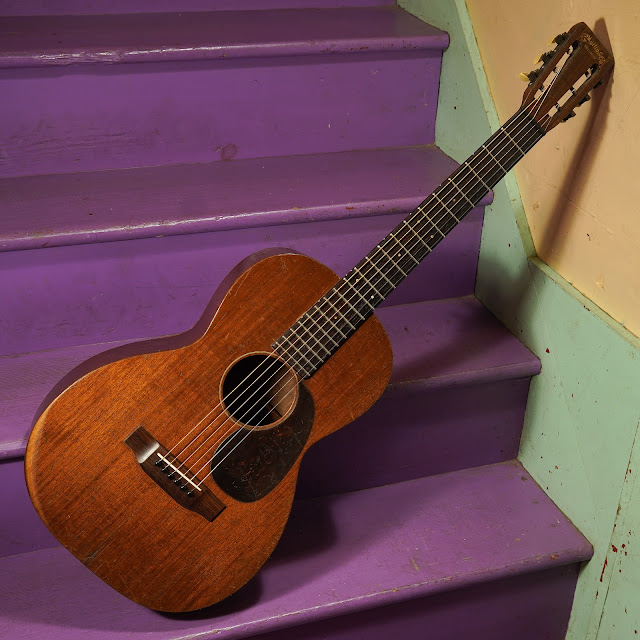1930s Martin 0-17H Flattop Guitar
I've written-up a lot of the "before times" funky aspects of this guitar in my "condition notes" writeup down the post, but to cut it short -- this was a pretty wonky soldier when it arrived in the shop and had a lot of bizarre old repairs. All the work has been done, however, and now it's a stellar little player and ready to go for the foreseeable future.
I used to own this same model of Martin (also converted to "Spanish" play from "Hawaiian") for a few years back in the day and so I've been a fan of this model for a long time. They have a punchy, woody, clean voice that suits fingerpicking and flatpicking, both, and the wide nut width and wider spacing at the bridge makes them right at home for countrified fingerpickers.
This started-off as a Hawaiian (raised-nut, slide-guitar) model and seems to have been played that way its entire life as the original nut was still extant (unmodified) when it got here. All sorts of other terrible repairs had been done to it, however, that needed sorting out. At the same time we converted it over to a regularly-fretted, "Spanish-necked" instrument.
Repairs included: a neck reset, board plane and refret, new bridge, crack re-repairs, seam re-repairs, brace regluing, new bone saddle, neck block repairs, small headstock crack repair, cleaning, setup, etc.
Weight: 3 lbs 5 oz
Scale length: 24 13/16"
Nut width: 1 7/8"
Neck shape: medium soft V/C
Board radius: flat
Body width: 13 5/8"
Body depth: 4 1/4"
Bridge string spacing: 2 1/4"
Top wood: solid mahogany
Back & sides wood: solid mahogany
Bracing type: x, scalloped
Bridge: rosewood (new)
Fretboard: rosewood (Brazilian)
Neck wood: mahogany
Action height at 12th fret: 3/32” bass 1/16” treble (fast, spot-on)
String gauges: 54w-12 lights
Truss rod: non-adjustable
Neck relief: straight
Fret style: medium-modern
Condition notes: oh, man, where to begin? For starters, when this arrived, the neck's heel (on the outside) looked like it does now, but I did have some fun removing multiple heavily-lodged-in bolts from the joint. The neck joint itself also had a break in one of its wings. There are currently a couple of small screws still stuck in the joint's wing for reinforcement and... unfortunately... you can see them at the neck block. Suffice to say, the neck block serial number was completely missing as it was under the rust from several large washers I removed. Oh well!
What's next? There are a number of repaired hairline cracks on the top (done before me, but the job was good enough) and some old repairs to hairline cracks on the side. The original bridge had been shaved-down and damaged. There was a small hairline crack at the headstock wing which got reglued. The original (full-height) Hawaiian-style nut got cut-down to serve its new role.
It had no side dots so it now has some. The side/back seam had been reglued in many areas a little "off" and so needed to be trimmed a bit. Finally, someone had used a rasp to "arm bevel" the lower bout top/side seam on the bass side. I mean, it was more comfortable... but the job was horrible! We rounded it back up so it's functional and while it looks a lot different in color in the photos, it's less obvious in person. It's tasteful.
Did I mention that the back of the heel and the finish and surface around the neck joint is a bit gross? Oh well, but it is. It's all stable and sturdy in there but it is what it is. The finish throughout the instrument, however, is original save the "touch-up" on the heel and the "arm bevel."
The fretboard had been cut at the 12th fret in a neck reset attempt before and during the refret we swapped-out the original flushfret bar frets with modern medium stock. The slots were all filled and the recut for the slots was undersized when installing the new wire so there's still some compression-fretting benefits for the neck.
It comes with: currently a chip case but it will ship in a hard case.
Consignor tag: A26





























Comments